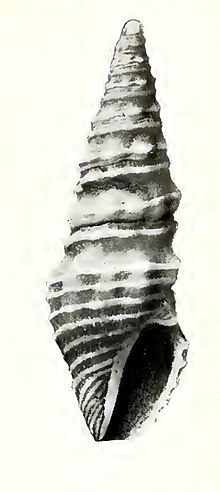Compsodrillia thestia Contents Description Distribution References External links Navigation menuCompsodrillia thestia (Dall, 1919)Dall (1919) Descriptions of new species of Mollusca from the North Pacific Ocean; Proceedings of the U.S. National Museum, vol. 56 (1920) This article incorporates text from this source, which is in the "Catalog of recent and fossil turrids (Mollusca: Gastropoda)""Compsodrillia thestia"403318230544725356510605131750685869433393
CompsodrilliaGastropods described in 1919
speciessea snailgastropodmolluskfamilyPseudomelatomidaeprotoconchwhorlsculpturespirebody whorlsiphonal canalapertureanal sulcuscalluslipcolumellaSea of Cortez
Compsodrillia thestia | |
|---|---|
 | |
| Original image of a shell of Compsodrillia thestia | |
Scientific classification | |
| Kingdom: | Animalia |
| Phylum: | Mollusca |
| Class: | Gastropoda |
Clade: | Caenogastropoda |
Clade: | Hypsogastropoda |
Clade: | Neogastropoda |
| Superfamily: | Conoidea |
| Family: | Pseudomelatomidae |
| Genus: | Compsodrillia |
| Species: | C. thestia |
Binomial name | |
Compsodrillia thestia (Dall, 1919) | |
Synonyms[1] | |
| |
Compsodrillia thestia is a species of sea snail, a marine gastropod mollusk in the family Pseudomelatomidae, the turrids and allies.[1]
Contents
1 Description
2 Distribution
3 References
4 External links
Description
The length of the shell attains 14 mm, its diameter 5 mm.
(Original description) The slender, acute shell is strongly sculptured, with pale brownish clouding on a yellowish white ground. The protoconch is smooth, inflated, and consists of 1½ whorl, followed by about eight sculptured whorls. The suture is distinct, undulated, strongly appressed, thick-edged, with a strong cord immediately behind the strongly constricted smooth anal fasciole. Other spiral sculpture consists of (on the spire one or two) strong peripheral cords, swollen and almost angulated where they override the ribs. On the body whorl there are six or seven cords with much wider interspaces and as many more smaller close-set threads on the siphonal canal. The axial sculpture consists of seven or eight very prominent short ribs on the penultimate whorl; fading out on the body whorl, and rather prominent widely spaced incremental lines most conspicuous on the body whorl. The aperture is subovate. The anal sulcus is conspicuous, rounded, with a marked subsutural callus. The outer lip is thin, moderately arcuate, not varicose. The inner lip shows a coat of enamel with the anterior edge raised. The columella is short, straight. The siphonal canal is hardly differentiated from the aperture.[2]
Distribution
This marine species occurs in the Sea of Cortez, Western Mexico.
References
^ ab Compsodrillia thestia (Dall, 1919). Retrieved through: World Register of Marine Species on 5 April 2010.
^ Dall (1919) Descriptions of new species of Mollusca from the North Pacific Ocean; Proceedings of the U.S. National Museum, vol. 56 (1920) This article incorporates text from this source, which is in the public domain.
This article incorporates text from this source, which is in the public domain.
External links
Tucker, J.K. (2004). "Catalog of recent and fossil turrids (Mollusca: Gastropoda)" (PDF). Zootaxa. 682: 1–1295..mw-parser-output cite.citationfont-style:inherit.mw-parser-output .citation qquotes:"""""""'""'".mw-parser-output .citation .cs1-lock-free abackground:url("//upload.wikimedia.org/wikipedia/commons/thumb/6/65/Lock-green.svg/9px-Lock-green.svg.png")no-repeat;background-position:right .1em center.mw-parser-output .citation .cs1-lock-limited a,.mw-parser-output .citation .cs1-lock-registration abackground:url("//upload.wikimedia.org/wikipedia/commons/thumb/d/d6/Lock-gray-alt-2.svg/9px-Lock-gray-alt-2.svg.png")no-repeat;background-position:right .1em center.mw-parser-output .citation .cs1-lock-subscription abackground:url("//upload.wikimedia.org/wikipedia/commons/thumb/a/aa/Lock-red-alt-2.svg/9px-Lock-red-alt-2.svg.png")no-repeat;background-position:right .1em center.mw-parser-output .cs1-subscription,.mw-parser-output .cs1-registrationcolor:#555.mw-parser-output .cs1-subscription span,.mw-parser-output .cs1-registration spanborder-bottom:1px dotted;cursor:help.mw-parser-output .cs1-ws-icon abackground:url("//upload.wikimedia.org/wikipedia/commons/thumb/4/4c/Wikisource-logo.svg/12px-Wikisource-logo.svg.png")no-repeat;background-position:right .1em center.mw-parser-output code.cs1-codecolor:inherit;background:inherit;border:inherit;padding:inherit.mw-parser-output .cs1-hidden-errordisplay:none;font-size:100%.mw-parser-output .cs1-visible-errorfont-size:100%.mw-parser-output .cs1-maintdisplay:none;color:#33aa33;margin-left:0.3em.mw-parser-output .cs1-subscription,.mw-parser-output .cs1-registration,.mw-parser-output .cs1-formatfont-size:95%.mw-parser-output .cs1-kern-left,.mw-parser-output .cs1-kern-wl-leftpadding-left:0.2em.mw-parser-output .cs1-kern-right,.mw-parser-output .cs1-kern-wl-rightpadding-right:0.2em
"Compsodrillia thestia". Gastropods.com. Retrieved 15 January 2019.
Compsodrillia, Gastropods described in 1919Uncategorized